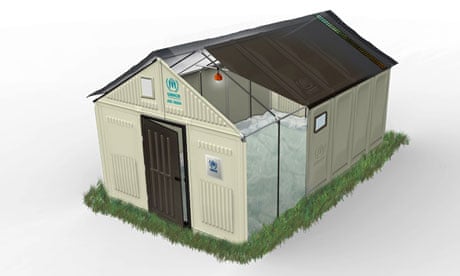Not content with filling our homes with £5 side tables and lining our stomachs with 50p hot dogs, Swedish furniture giant Ikea has been known to diversify – from building a post-Olympic model village in east London, to launching a range of budget hotels. But its most recent venture is the most ambitious yet: the company is attempting to bring its flatpack, no frills efficiency to the problem of refugee housing.
"Our tents have not evolved very much over the years," says Olivier Delarue, from the UN Refugee Agency (UNHCR). "They still rely on canvas, ropes and poles – and they usually only last for around six months due to harsh climate conditions."
Ikea's design, a cross between a giant garden shed and a khaki canvas marquee, is formed from lightweight laminated panels that clip on to a simple frame, providing UV protection and thermal insulation. Like an Ikea product, the polymer panels come packed in a box, along with a bag of pipes, connectors and wires – and no doubt a cartoon construction manual.
"It is designed this way, like an Ikea bookshelf, to be easy to transport and easy to set up in the field," says Johan Karlsson, project manager of Ikea's Refugee Housing Unit. "And the panels can last up to three years."
The kit also incorporates a fabric shading sheet with a metallic layer that reflects the sun during the day and keeps the heat in at night, as well as a solar panel to provide the shelter with power.
"We realised that the plastic sheeting UNHCR was using to build temporary refugee shelters was almost exactly the same material that Ikea used for their bags in stores," says Delarue. "We also realised that Ikea had expertise in certain areas – such as logistics and flatpacking – that we could learn from."
UNHCR estimates that 10% of the world's refugee population live in tents, many of which don't provide adequate insulation from the heat or the cold and offer no electricity, with the average stay in a camp being around 12 years. The organisation currently uses two kinds of tent – the canvas ridge variety, similar to a traditional Scout tent, and a lightweight hoop tent. Neither are particularly durable.
"Everyone has been trying to crack the problem of humanitarian emergency tentage for a long time," says Tom Corsellis, director of NGO Shelter Centre, who has worked on co-ordinating refugee camps in Haiti, Sri Lanka and the Balkans. "The Ikea design is a positive and promising contribution, with better climatic potential than the current tents. The square form with vertical walls and a pitched roof also allows the structure to be upgraded over time – mud walls and a corrugated galvanised iron roof could easily be added to make a longer-lasting shelter."
The Ikea Foundation has pumped around £3m into developing the project, which is still at prototype stage. Around 50 of the trial tents, which can each accommodate five people, are set to be tested in Ethiopia, for Somali refugees living in UN refugee camps at Dollo Ado, as well as for refugees in Iraq and Lebanon.
"We're not there yet," says Paul Spiegel of UNHCR. "But this is already very huge, and we will be testing in a lot of different locations and gather data about changes. Then we hopefully go full scale." Let's just hope they remember to pack the allen key.

Comments (…)
Sign in or create your Guardian account to join the discussion